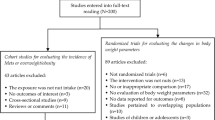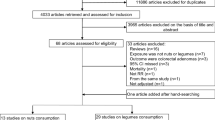Abstract
Purpose
There is inconsistent evidence regarding the relationship between higher intake of nuts, being an energy-dense food, and weight gain. We investigated the relationship between nut intake and changes in weight over 5 years.
Methods
This study includes 373,293 men and women, 25–70 years old, recruited between 1992 and 2000 from 10 European countries in the European Prospective Investigation into Cancer and Nutrition (EPIC) study. Habitual intake of nuts including peanuts, together defined as nut intake, was estimated from country-specific validated dietary questionnaires. Body weight was measured at recruitment and self-reported 5 years later. The association between nut intake and body weight change was estimated using multilevel mixed linear regression models with center/country as random effect and nut intake and relevant confounders as fixed effects. The relative risk (RR) of becoming overweight or obese after 5 years was investigated using multivariate Poisson regressions stratified according to baseline body mass index (BMI).
Results
On average, study participants gained 2.1 kg (SD 5.0 kg) over 5 years. Compared to non-consumers, subjects in the highest quartile of nut intake had less weight gain over 5 years (−0.07 kg; 95% CI −0.12 to −0.02) (P trend = 0.025) and had 5% lower risk of becoming overweight (RR 0.95; 95% CI 0.92–0.98) or obese (RR 0.95; 95% CI 0.90–0.99) (both P trend <0.008).
Conclusions
Higher intake of nuts is associated with reduced weight gain and a lower risk of becoming overweight or obese.
Similar content being viewed by others
References
Estruch R, Ros E, Salas-Salvado J et al (2013) Primary prevention of cardiovascular disease with a Mediterranean diet. N Engl J Med 368:1279–1290. doi:10.1056/NEJMoa1200303
Bao Y, Han J, Hu FB et al (2013) Association of nut consumption with total and cause-specific mortality. N Engl J Med 369:2001–2011. doi:10.1056/NEJMoa1307352
Nash SD, Nash DT (2008) Nuts as part of a healthy cardiovascular diet. Curr Atheroscler Rep 10:529–535
Sabate J, Ang Y (2009) Nuts and health outcomes: new epidemiologic evidence. Am J Clin Nutr 89:1643S–1648S. doi:10.3945/ajcn.2009.26736Q
Aune D, Keum N, Giovannucci E et al (2016) Nut consumption and risk of cardiovascular disease, cancer, all-cause and cause-specific mortality: a systematic review and dose-response meta-analysis of prospective studies. BMC Med 14:207–220. doi:10.1186/s12916-016-0730-3
Wang W, Yang M, Kenfield SA et al (2016) Nut consumption and prostate cancer risk and mortality. Br J Cancer 115:371–374. doi:10.1038/bjc.2016.181
Nakanishi M, Chen Y, Qendro V et al (2016) Effects of walnut consumption on colon carcinogenesis and microbial community structure. Cancer Prev Res (Phila). doi:10.1158/1940-6207.CAPR-16-0026
Jenab M, Ferrari P, Slimani N et al (2004) Association of nut and seed intake with colorectal cancer risk in the European Prospective Investigation into Cancer and Nutrition. Cancer Epidemiol Biomarkers Prev 13:1595–1603
Appel LJ, Van Horn L (2013) Did the PREDIMED trial test a Mediterranean diet? N Engl J Med 368:1353–1354. doi:10.1056/NEJMe1301582
Jackson CL, Hu FB (2014) Long-term associations of nut consumption with body weight and obesity. Am J Clin Nutr 100:408–411. doi:10.3945/ajcn.113.071332
Flores-Mateo G, Rojas-Rueda D, Basora J et al (2013) Nut intake and adiposity: meta-analysis of clinical trials. Am J Clin Nutr 97:1346–1355. doi:10.3945/ajcn.111.031484
Estruch R, Martínez-González MA, Corella D et al (2016) Effect of a high-fat Mediterranean diet on bodyweight and waist circumference: a prespecified secondary outcomes analysis of the PREDIMED randomised controlled trial. Lancet Diabetes Endocrinol 4:666–676. doi:10.1016/S2213-8587(16)30085-7
Bes-Rastrollo M, Sabate J, Gomez-Gracia E et al (2007) Nut consumption and weight gain in a Mediterranean cohort: the SUN study. Obesity (Silver Spring) 15:107–116. doi:10.1038/oby.2007.507
Bes-Rastrollo M, Wedick NM, Martinez-Gonzalez M et al (2009) Prospective study of nut consumption, long-term weight change, and obesity risk in women. Am J Clin Nutr 89:1913–1919
Jiang R, Manson JE, Stampfer MJ et al (2002) Nut and peanut butter consumption and risk of type 2 diabetes in women. JAMA 288:2554–2560
Martínez-González M, Bes-Rastrollo M (2011) Nut consumption, weight gain and obesity: epidemiological evidence. Nutr Metab Cardiovasc Dis 21:40–45. doi:10.1016/j.numecd.2010.11.005
Mozaffarian D, Hao T, Rimm E et al (2011) Changes in diet and lifestyle and long-term weight gain in women and men. N Engl J Med 364:2392–2404
O’Neil CE, Keast DR, Fulgoni VL, Nicklas T (2010) Tree nut consumption improves nutrient intake and diet quality in US adults: an analysis of national health and nutrition examination survey (NHANES) 1999–2004. Asia Pac J Clin Nutr 19:142–150
Riboli E, Kaaks R (1997) The EPIC Project: rationale and study design. European Prospective Investigation into Cancer and Nutrition. Int J Epidemiol 26(Suppl 1):S6–S14
Riboli E, Hunt K, Slimani N et al (2002) European Prospective Investigation into Cancer and Nutrition (EPIC): study populations and data collection. Public Health Nutr 5:1113. doi:10.1079/PHN2002394
Vergnaud AC, Norat T, Romaguera D et al (2012) Fruit and vegetable consumption and prospective weight change in participants of the European prospective investigation into cancer and nutrition-physical activity, nutrition, alcohol, cessation of smoking, eating out of home, and obesity study. Am J Clin Nutr 95:184–193. doi:10.3945/ajcn.111.019968
Vergnaud AC, Norat T, Romaguera D et al (2010) Meat consumption and prospective weight change in participants of the EPIC-PANACEA study. Am J Clin Nutr 92:398–407. doi:10.3945/ajcn.2009.28713
Spencer E, Appleby PN, Davey GK, Key TJ (2002) Validity of self-reported height and weight in 4808 EPIC-Oxford participants. Public Health Nutr 5:561–565. doi:10.1079/PHN2001322
Buckland G, González CA, Agudo A et al (2009) Adherence to the mediterranean diet and risk of coronary heart disease in the spanish EPIC cohort study. Am J Epidemiol 170:1518–1529. doi:10.1093/aje/kwp282
Peters T, Brage S, Westgate K et al (2012) Validity of a short questionnaire to assess physical activity in 10 European countries. Eur J Epidemiol 27:15–25. doi:10.1007/s10654-011-9625-y
Orsini N, Greenland S (2011) A procedure to tabulate and plot results after flexible modeling of a quantitative covariate. Stata J 11:1–29
Higgins JPT, Thompson SG (2002) Quantifying heterogeneity in a meta-analysis. Stat Med. doi:10.1002/sim.1186
Zou G (2004) A modified poisson regression approach to prospective studies with binary data. Am J Epidemiol 159:702–706. doi:10.1093/aje/kwh090
Rouhani MH, Salehi-Abargouei A, Surkan PJ, Azadbakht L (2014) Is there a relationship between red or processed meat intake and obesity? A systematic review and meta-analysis of observational studies. Obes Rev 15:740–748. doi:10.1111/obr.12172
Romaguera D, Norat T, Vergnaud A-C et al (2010) Mediterranean dietary patterns and prospective weight change in participants of the EPIC-PANACEA project. Am J Clin Nutr 92:912–921. doi:10.3945/ajcn.2010.29482
Vadivel V, Kunyanga CN, Biesalski HK (2012) Health benefits of nut consumption with special reference to body weight control. Nutrition 28:1089–1097. doi:10.1016/j.nut.2012.01.004
Park JY, Mitrou PN, Keogh RH et al (2012) Self-reported and measured anthropometric data and risk of colorectal cancer in the EPIC-Norfolk study. Int J Obes (Lond) 36:107–118. doi:10.1038/ijo.2011.61
Smith JD, Hou T, Hu FB et al (2015) A comparison of different methods for evaluating diet, physical activity, and long-term weight gain in 3 prospective cohort studies. J Nutr 145:2527–2534. doi:10.3945/jn.115.214171
Gottschald M, Knüppel S, Boeing H, Buijsse B (2016) The influence of adjustment for energy misreporting on relations of cake and cookie intake with cardiometabolic disease risk factors. Eur J Clin Nutr 70:1318–1324. doi:10.1038/ejcn.2016.131
Mora-Cubillos X, Tulipani S, Garcia-Aloy M et al (2015) Plasma metabolomic biomarkers of mixed nuts exposure inversely correlate with severity of metabolic syndrome. Mol Nutr Food Res 59:2480–2490. doi:10.1002/mnfr.201500549
Acknowledgements
This publication arises from the project PANACEA, which has received funding from the European Union, in the framework of the Public Health Programme (Project Number: 2005328). The coordination of EPIC is financially supported by the European Commission (DG-SANCO) and the International Agency for Research on Cancer. The national cohorts are supported by Danish Cancer Society (Denmark); Ligue Contre le Cancer, Institut Gustave Roussy, Mutuelle Générale de l’Education Nationale, Institut National de la Santé et de la Recherche Médicale (INSERM) (France); German Cancer Aid, German Cancer Research Center (DKFZ), Federal Ministry of Education and Research (BMBF), Deutsche Krebshilfe, Deutsches Krebsforschungszentrum and Federal Ministry of Education and Research (Germany); the Hellenic Health Foundation (Greece); Associazione Italiana per la Ricerca sul Cancro-AIRC-Italy and National Research Council (Italy); Dutch Ministry of Public Health, Welfare and Sports (VWS), Netherlands Cancer Registry (NKR), LK Research Funds, Dutch Prevention Funds, Dutch ZON (Zorg Onderzoek Nederland), World Cancer Research Fund (WCRF), Statistics Netherlands (The Netherlands); Nordic Centre of Excellence programme on Food, Nutrition and Health (Norway); Health Research Fund (FIS), PI13/00061 to Granada; PI13/01162 to EPIC-Murcia), Regional Governments of Andalucía, Asturias, Basque Country, Murcia and Navarra, ISCIII RETIC (RD06/0020) (Spain); Swedish Cancer Society, Swedish Research Council and County Councils of Skåne and Västerbotten (Sweden); Cancer Research UK (14136 to EPIC-Norfolk; C570/A16491 and C8221/A19170 to EPIC-Oxford), Medical Research Council (1000143 to EPIC-Norfolk, MR/M012190/1 to EPIC-Oxford) (United Kingdom). The current study was financially supported by Loma Linda University (LLU Contract No. 2150183). JS received funding from the INC International Nut and Dried Fruit Council. The funders had no role in study design, data collection and analysis, decision to publish, or preparation of the manuscript.
Author information
Authors and Affiliations
Contributions
We thank all EPIC participants and staff for their contribution to the study. For information on how to submit an application for gaining access to EPIC data and/or biospecimens, please follow the instructions at http://epic.iarc.fr/access/index.php.
Corresponding author
Ethics declarations
Ethical standards
The study has been performed in accordance with the ethical standards laid down in the 1964 Declaration of Helsinki and its later amendments and obtained ethical approval from participating centres and IARC ethics committees. Informed consent was given by all study participants.
Conflict of interest
The authors declare that they have no conflict of interest.
Electronic supplementary material
Below is the link to the electronic supplementary material.
Rights and permissions
About this article
Cite this article
Freisling, H., Noh, H., Slimani, N. et al. Nut intake and 5-year changes in body weight and obesity risk in adults: results from the EPIC-PANACEA study. Eur J Nutr 57, 2399–2408 (2018). https://doi.org/10.1007/s00394-017-1513-0
Received:
Accepted:
Published:
Issue Date:
DOI: https://doi.org/10.1007/s00394-017-1513-0




